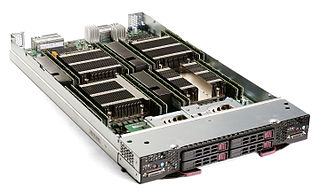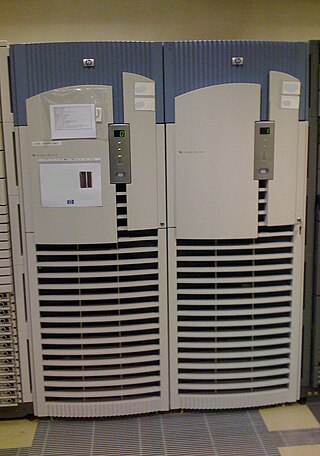
A backplane or backplane system is a group of electrical connectors in parallel with each other, so that each pin of each connector is linked to the same relative pin of all the other connectors, forming a computer bus. It is used to connect several printed circuit boards together to make up a complete computer system. Backplanes commonly use a printed circuit board, but wire-wrapped backplanes have also been used in minicomputers and high-reliability applications.

In computer hardware a host controller, host adapter or host bus adapter (HBA) connects a computer system bus which acts as the host system to other network and storage devices. The terms are primarily used to refer to devices for connecting SCSI, SAS, NVMe, Fibre Channel and SATA devices. Devices for connecting to FireWire, USB and other devices may also be called host controllers or host adapters.

A blade server is a stripped-down server computer with a modular design optimized to minimize the use of physical space and energy. Blade servers have many components removed to save space, minimize power consumption and other considerations, while still having all the functional components to be considered a computer. Unlike a rack-mount server, a blade server fits inside a blade enclosure, which can hold multiple blade servers, providing services such as power, cooling, networking, various interconnects and management. Together, blades and the blade enclosure form a blade system, which may itself be rack-mounted. Different blade providers have differing principles regarding what to include in the blade itself, and in the blade system as a whole.
Brocade was an American technology company specializing in storage networking products, now a subsidiary of Broadcom Inc. The company is known for its Fibre Channel storage networking products and technology. Prior to the acquisition, the company expanded into adjacent markets including a wide range of IP/Ethernet hardware and software products. Offerings included routers and network switches for data center, campus and carrier environments, IP storage network fabrics; Network Functions Virtualization (NFV) and software-defined networking (SDN) markets such as a commercial edition of the OpenDaylight Project controller; and network management software that spans physical and virtual devices.
Advanced Telecommunications Computing Architecture is the largest specification effort in the history of the PCI Industrial Computer Manufacturers Group (PICMG), with more than 100 companies participating. Known as AdvancedTCA, the official specification designation PICMG 3.x was ratified by the PICMG organization in December 2002. AdvancedTCA is targeted primarily to requirements for "carrier grade" communications equipment, but has recently expanded its reach into more ruggedized applications geared toward the military/aerospace industries as well. This series of specifications incorporates the latest trends in high speed interconnect technologies, next-generation processors, and improved Reliability, Availability and Serviceability (RAS).
Integrated Lights-Out, or iLO, is a proprietary embedded server management technology by Hewlett-Packard Enterprise which provides out-of-band management facilities. The physical connection is an Ethernet port that can be found on most ProLiant servers and microservers of the 300 and above series.

The IBM BladeCenter was IBM's blade server architecture, until it was replaced by Flex System in 2012. The x86 division was later sold to Lenovo in 2014.
The current portfolio of PowerConnect switches are now being offered as part of the Dell Networking brand: information on this page is an overview of all current and past PowerConnect switches as per August 2013, but any updates on current portfolio will be detailed on the Dell Networking page.

ProLiant is a brand of server computers that was originally developed and marketed by Compaq, Hewlett-Packard (HP), and currently marketed by Hewlett Packard Enterprise (HPE). ProLiant servers were first introduced by Compaq in 1993, succeeding their SystemPro line of servers in the high-end space.
Dell Force10, was a United States company that developed and marketed 10 Gigabit and 40 Gigabit Ethernet switches for computer networking to corporate, educational, and governmental customers. It had offices in North America, Europe, and the Asia Pacific region.

The HPE Superdome is a high-end server computer designed and manufactured by Hewlett Packard Enterprise. The product's most recent version, "Superdome 2," was released in 2010 supporting 2 to 32 sockets and 4 TB of memory. The Superdome used PA-RISC processors when it debuted in 2000. Since 2002, a second version of the machine based on Itanium 2 processors has been marketed as the HP Integrity Superdome.
The Cisco Nexus series switches are modular and fixed port network switches designed for the data center. Cisco Systems introduced the Nexus Series of switches on January 28, 2008. The first chassis in the Nexus 7000 family is a 10-slot chassis with two supervisor engine slots and eight I/O module slots at the front, as well as five crossbar switch fabric modules at the rear. Beside the Nexus 7000 there are also other models in the Nexus range.
The Juniper T series is a line of core routers designed and manufactured by Juniper Networks. The T-series core router family comprises the T320, T640, T1600, T4000, TX Matrix, and TX Matrix Plus, designed for high-end and core networks with throughput from 320 Gbit/s to 25.6 Tbit/s with a maximum forwarding rate of 30.7 billion pps. The JCS1200, the industry's only independent control plane scaling system, brings virtualization to the core of the network. The TX Matrix Plus provides transport scale up to 25 Tbit/s. The T-series routers run Junos OS.
EqualLogic, Inc. was an American computer data storage company based in Nashua, New Hampshire, active from 2001 to 2007. In 2008, the company was merged into Dell Inc. Dell-branded EqualLogic products are iSCSI-based storage area network (SAN) systems. Dell has 3 different lines of SAN products: EqualLogic, Compellent and Dell PowerVault.
IBM Storwize systems were virtualizing RAID computer data storage systems with raw storage capacities up to 32 PB. Storwize is based on the same software as IBM SAN Volume Controller (SVC).
Cisco Unified Computing System (UCS) is a data center server computer product line composed of server hardware, virtualization support, switching fabric, and management software, introduced in 2009 by Cisco Systems. The products are marketed for scalability by integrating many components of a data center that can be managed as a single unit.

The Dell blade server products are built around their M1000e enclosure that can hold their server blades, an embedded EqualLogic iSCSI storage area network and I/O modules including Ethernet, Fibre Channel and InfiniBand switches.
Avaya Virtual Services Platform 7000 Series or VSP 7000 is a set standalone/Stackable Switches, used in enterprise data networks, and data centers, manufactured by Avaya. This product is primarily offered to satisfy the Top-of-Rack (ToR) role for server farms and virtualized data centers. It supports Avaya's extended Shortest Path Bridging (SPB) implementation "Fabric Connect", and is future-ready for Edge Virtual Bridging (EVB) – IEEE 802.1Qbg, and Fiber Channel over Ethernet (FCoE). The system incorporates fifth generation application-specific integrated circuit (ASIC) chips with redundant and hot-swappable power supplies, fans, and expansion modules. The VSP 7000's unique architecture allows it to be meshed—fully or partially—with like devices, creating a high-capacity, low-latency network of up to 500 units, supporting up to 16,000 ports of 10GbE supported by a virtual backplane of up to 280 Tbit/s
HP Virtual Connect is a virtualization technology created by Hewlett-Packard (HP) that de-couples fixed blade server adapter network addresses from the associated external networks so that changes in the blade server infrastructure and the LAN and SAN environments don’t require choreography among server, LAN, and SAN teams for every task. It brings virtualization to the blade server edge as it extends virtual machine technology. Virtual machine technology moves workloads across virtual machines on a single server. It becomes a challenge when moving virtual machines from one physical machine to another or between data center locations because changes to the LAN and SAN environments require manual intervention by network and storage administrators. By pooling and sharing multiple network connections across multiple servers and virtual machines, Virtual Connect extends the capability of Data Center by allowing physical setup and movement of Virtual Machine workloads between servers and Virtual Machines, transparently from the LAN and SAN infrastructure. Another name for Virtual Connect is PowerConnect Switches.









